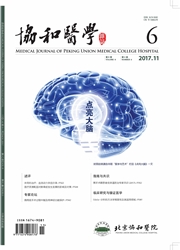

 中文摘要:
中文摘要:
目的评估超小超顺磁性氧化铁(ultrasmall superparamagnetic iron oxide,USPIO)标记SD大鼠脂肪来源干细胞(adipose derived stem cells,ADSCs)的有效性及安全性,探讨标记细胞体外磁共振成像(magnetic resonance ima-ging,MRI)特点。方法将USPIO40μg/ml及多聚赖氨酸(poly-L-lysine,PLL)1.5μg/ml的培养基与ADSCs共孵育培养24h,检测USPIO标记的有效性及安全性,并用MRI对标记细胞进行体外成像。结果普鲁士蓝染色显示USPIO标记ADSCs的阳性率为99%,透射电镜提示USPIO颗粒主要位于胞质内溶酶体中;台盼蓝染色实验显示活细胞数大于95%,MTS[3-(4,5-dimethylthiazol-2-yl)-5(3-carboxymethoxyphenyl)-2-(4-sulfopheny)-2H-tetrazolium,溴化噻唑蓝四氮唑]实验提示USPIO浓度为10、20、40、80和160μg/ml时不影响ADSCs增殖。ELISA结果表明标记细胞与未标记细胞组间培养液中血管内皮生长因子(vascular endothelial growth factor,VEGF)水平无显著差异;体外条件下,MRI图像信号强度与标记细胞数量呈正相关。结论 USPIO标记ADSCs安全有效,MRI图像信号强度与标记细胞数量存在一定相关性,提示USPIO可用于在体条件下MRI成像示踪标记细胞。
 英文摘要:
英文摘要:
Objective To investigate the efficacy and safety of ultrasmall superparamagnetic iron oxide (USPIO) labeling adipose derived stem cells(ADSCs)of SD rats and explore the feasibility of tracing labeled cells with magnetic resonance imaging (MRI). Methods ADSCs were incubated with culture medium containing USPIO and poly-L-lysine (PLL) for 24h. The efficacy and safety of labling with USPIO was assessed, and the labeled cells were imaged with MRI in vitro. Results Prussian blue staining showed the percentage of labeled ADSCs reached 99% after coincubating for 24 h. Transmission electron microscopy showed iron particles inside the cells were mainly in lysosomes. Trypan-Blue stain showed the proportion of living cells was greater than 95%. MTS[3-(4,5-dimethylthiazol-2-yl)-5(3-carboxymethoxyphenyl)-2-(4-sulfopheny)-2H-tetrazolium] experiments suggested that USPIO at different concentrations (10, 20, 40, 80, 160μg/ml) exerted no significant influence on the proliferation of ADSCs. Enzyme-linked immunosorbent assay (ELISA) revealed VEGF level was not significantly different between labeled cells and unlabeled cells. The signal intensity of MRI was positively correlated with the amount of labeled cells in vitro. Conclusion USPIO is safe and efficient in labeling ADSCs and the signal intensity of MRI is associated with the amount of labeled cells, indicating that USPIO can be used for tracing the labled cells under MRI in vitro.
 同期刊论文项目
同期刊论文项目
 同项目期刊论文
同项目期刊论文
 Prospectively ECG-triggered sequential dual-source coronary CT angiography in patients with atrial f
Prospectively ECG-triggered sequential dual-source coronary CT angiography in patients with atrial f 128-slice Dual-source Computed Tomography Coronary Angiography in Patients with Atrial Fibrillation:
128-slice Dual-source Computed Tomography Coronary Angiography in Patients with Atrial Fibrillation: Feasibility of Low-Dose Contrast Medium High Pitch CT Angiography for the Combined Evaluation of Cor
Feasibility of Low-Dose Contrast Medium High Pitch CT Angiography for the Combined Evaluation of Cor 期刊信息
期刊信息
